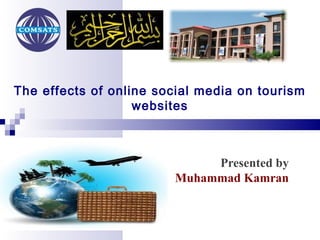
The effects of online social media on tourism websites
- 1. The effects of online social media on tourism websites Department of Computer Science Presented by DCS Muhammad Kamran COMSATS Institute of Information Technology
- 2. Research Author. Authors: Roberta Milano Rodolfo Baggio Robert Piattellib Published At: University of Genova Italy On 2011 Department of Computer Science 2
- 3. Outline Abstract Introduction Research and methodology Results Discussion Conclusions Department of Computer Science 3
- 4. Abstract This paper aims at verifying the impact that online social networks (OSN) have on the popularity of tourism websites. Web 2.0 and online social networking websites heavily effect today most of online activities and their effect on tourism is obviously important. Two OSNs have been considered: Facebook and Twitter. Pattern of visits to a sample tourism websites was analyzed and relationship between the total visits and Online SN as referral measures. Analysis show a clear correlation and confirm hypothecs. Department of Computer Science 4
- 5. Introduction At the close of the 20th century.....internet had enormous diffusion and radically changed most of our economic and social life. Revolution has impact the way communicate, work and conduct business. SN’s change how we can get tourism related information how we plan for and consume travel. Impact of Web 2.0 and Social Media Websites liker wiki, Flicker, play important role for promote tourism in the world Travel 2.0 and OSN Increase no of visitors to online tourism websites Department of Computer Science 5
- 6. Web 2.0 and Travel 2.0 Web 2.0 Travel 2.0 A second generation of services available on Pre-experience the W W W that let people collaborate, and built on people stories, before travaling share information online. In contrast to the Experience during travel sharing thourg cell first generation, Web 2.0 gives users an phone experience closer to desktop applications Post experience blog, comments than the traditional static Web pages E.g. Trip Advisor, travel blog, sarahotel Department of Computer Science 6
- 7. Tools for Travel 2.0 Department of Computer Science 7
- 8. Tools for Travel 2.0 Department of Computer Science 8
- 9. Background Tourism are important components of online commerce of the world whose impact has profoundly changed the structure of the industry. SN’ provide informatiom to consumer and industry supplier, hotel , transpotaiton,travel agent. With the introduction Web 2.0 features and applications, tourism markets have become real conversations on one of the most thrilling subject for a human being. OSN such as facebook play important role for a growth of tourism industry in the world. which is largest and widespread SN of the world. Department of Computer Science 9
- 10. Facebook Most widespread OSN. Collect 67% tourism related info from web. Department of Computer Science 10
- 11. Italy being at 1st places in world usage of facebook. 17 million Italian people are facebook user. 56% of population. Sixth place in country ranking Department of Computer Science 11
- 12. Research and methodology More than 275,000 italian websites use for analysis. Cumulative data were collected concerning the visits to 19,902. from website. The time spanframe spans a two year. The data collected consited of the series of total visits to Italian website(TOT) and contrubutin to these visits having Facebook(FB) and Twiter as refferals Each visit uses 30 minutes time window. all connection to a website coming from same ip address. Gloabal series: a series consisting of linear composition of a number of different contrubutin.in order to assess the significance of these contrubution to gloabal series. Department of Computer Science 12
- 13. Research and methodology Time period is dependable variable and FB and Twiter contributions are predictors. Department of Computer Science 13
- 14. Results The tme series for total visits to Italian tourism websites(TOT) and FB given bellow. Max value for the contribution of FB and TW Recored in the month of August: FB = 0.329% ; TW = 0.002% Department of Computer Science 14
- 15. Total visits to Italian tourism websites (TOT) and contribution to the visits from Facebook (FB). TW contributions are not reported for their very low values Department of Computer Science 15
- 16. Seasonality indices of the visits to websites fortotal visits (TOT) and Facebook (FB) and Twitter (TW) contributions Department of Computer Science 16
- 17. regression analysis Condition index (last column) when value higher 15 is concern, when higher then 30 is serious problem. The regression analysis shows the positive importance and the significance of the FB contributions to the total number of visits to a tourism website. Department of Computer Science 17
- 18. Discussion /Conclusions The main goal of this work to show the effects of web 2.0 features, specially social network on the popularity of tourism websites. Contribution of soical media websites examine are of a low level. higher proportion would be expected but show limited usage of web 2.0 functionalities by tourism websites in each country. Despite that, the growth of the FB and TW components is quite remarkable, mainly if we compare with the limited increase in total visits. Department of Computer Science 18
- 19. THANK YOU FOR YOUR ATTENTION! Department of Computer Science 19
Notas do Editor
- The maximum values for the contributions of FB and TW visits are recorded in the month of August 2010: FB = 0.329%; TW = 0.002%. When examining the series transformed into an index with the starting observation taken as base, TOT gets to 120 at the end of the period examined, while FB reaches 9438 and TW achieve 2280.
- All the series show a marked seasonality with a peak in the summer months. This is typical of the Italian vacation patterns.
